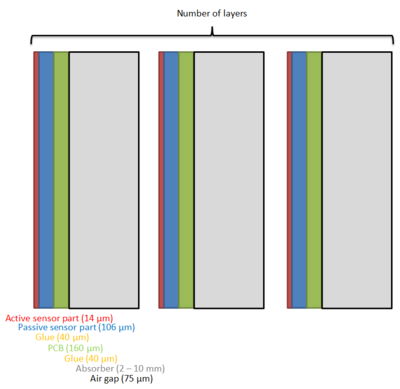DTC optimization: Difference between revisions
| Line 53: | Line 53: | ||
=== Accuracy === | === Accuracy === | ||
[[File:accuracy_2mm.png| | [[File:accuracy_2mm.png|800px]] | ||
[[File:accuracy_3mm.png| | [[File:accuracy_3mm.png|800px]] | ||
[[File:accuracy_4mm.png| | [[File:accuracy_4mm.png|800px]] | ||
[[File:accuracy_5mm.png| | [[File:accuracy_5mm.png|800px]] | ||
[[File:accuracy_6mm.png| | [[File:accuracy_6mm.png|800px]] | ||
[[File:accuracy_7mm.png| | [[File:accuracy_7mm.png|800px]] | ||
Revision as of 11:15, 23 March 2017
Geometry and segmentation optimization of the Digital Tracking Calorimeter
Optimization philosophy
Geometry
Materials
Software
The software for this project is Gate installation and the DTC toolkit. For a complete guide to use the software for optimization, see the page Software for design optimization.
Results
Resolution
All following values are given in units of Water Equivalent Thickness! (Except the absorber thicknesses)
Pre-straggling resolution is the contribution to the total resolution from the detector smearing. This is calculable because we know the range straggling from Monte Carlo simulations, and the pre-straggling resolution is a subtraction in quadrature.
| Material | Thickness | [math]\displaystyle{ t / \sqrt{12} }[/math] WEPL | Resolution | Excess straggling | Pre-straggling resolution | Layers for 230 MeV + [math]\displaystyle{ 5\sigma }[/math] |
|---|---|---|---|---|---|---|
| Al | 2 mm | 1.5 mm | 4.16 mm | 6.1% | 1.38 mm | 67 |
| Al | 3 mm | 2.1 mm | 4.26 mm | 9.2% | 1.69 mm | 48 |
| Al | 4 mm | 2.7 mm | 4.35 mm | 12.4% | 1.97 mm | 39 |
| Al | 5 mm | 3.3 mm | 4.50 mm | 16.4% | 2.28 mm | 32 |
| Al | 6 mm | 3.9 mm | 4.70 mm | 23.3% | 2.73 mm | 27 |
| Al | 7 mm | 4.5 mm | 4.76 mm | 26.0% | 2.78 mm | 23 |













